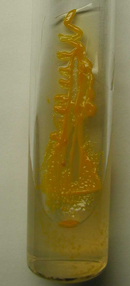 |
A culture of Mycobacterium nebraskense. The culture material contains billions of bacterial cells enabling one to “see” the bacterium. The actual individual bacterial cell is microscopic and can only be visualized under the microscope. |
Called M. nebraskense or nebraskense, the organism was discovered by UNMC scientists using scientifically advanced molecular diagnostics while trying to find the cause of mysterious life-threatening lung infections in some cancer patients.
Mycobacterium nebraskense, is closely related to bacteria that cause diseases such as tuberculosis and leprosy. Although the source of nebraskense has not been identified, it is suspected to be associated with the environment, such as the soil and water. The slow-growing bacterium is known to cause chronic lung infections, including pneumonia.
“Not only have we recognized an unusual pathogen and been able to characterize it as a new species, we’ve also identified it in patients,” said Pete Iwen, Ph.D., a UNMC microbiologist who was part of the team that discovered nebraskense.
In late 2006 in the journal Diagnostic Microbiology and Infectious Disease,” UNMC scientists published the world’s first case study describing how the microorganism affects patients. UNMC researchers in 2004 first documented its existence by publishing the discovery in the International Journal of Systematic and Evolutionary Microbiology.
Name recognition will help health care professionals more effectively treat patients infected with the previously unknown microorganism.
The scientific discovery is prestigious in the world of microbiology. Not only does it allow clinical laboratory scientists around the world to recognize this unusual pathogen, it also enables health professionals to use the most appropriate treatment.
“Anytime a new organism is identified, laboratorians and others in the medical field want to know more about how it will affect patient care,” Dr. Iwen said. “Our next goal is help develop diagnostic tests for the patient.”
Since M. nebraskense has been identified, more patient cases have been recorded around the world, Dr. Iwen said.
Other members of the research team included: Amr Mohamed, Ph.D., former UNMC graduate student, Steven Hinrichs, M.D., UNMC professor of pathology and microbiology and microbiology, and Stefano Tarantolo, M.D., a former UNMC faculty member who now is an Omaha private practice oncologist.